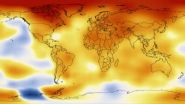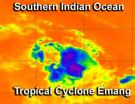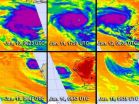(Press-News.org) In addition to causing smoggy skies and chronic coughs, soot – or black carbon – turns out to be the number two contributor to global warming. It's second only to carbon dioxide, according to a four-year assessment by an international panel.
The new study concludes that black carbon, the soot particles in smoke and smog, contributes about twice as much to global warming as previously estimated, even by the 2007 Intergovernmental Panel on Climate Change.
"We were surprised at its potential contribution to climate," said Sarah Doherty, a University of Washington atmospheric scientist and one of four coordinating lead authors.
The silver lining may be that controlling these emissions can deliver more immediate climate benefits than trying to control carbon dioxide, she said.
The paper was made freely available online today (Jan. 15) in the Journal of Geophysical Research-Atmospheres.
Some previous research had hinted that models were underestimating black-carbon emissions, Doherty said, from such things as open burning of forests, crops and grasslands, and from energy-related emissions in Southeast Asia and East Asia.
Black carbon's role in climate is complex. Dark particles in the air work to shade the Earth's surface while warming the atmosphere. Black carbon that settles on the surface of snow and ice darkens the surface to absorb more sunlight and increase melting. Finally, soot particles influence cloud formation in ways that can have either a cooling or warming impact.
The report surveyed past studies and included new research to quantify the sources of black carbon and better understand its overall effect on the climate.
Doherty was executive director of the International Global Atmospheric Chemistry Project in 2009 when policy groups were seeking better information on the benefits of reducing black-carbon emissions. The scientific body undertook a comprehensive assessment, supported by IGAC and the U.S. National Oceanic and Atmospheric Administration.
"Because of a lack of action to reduce carbon dioxide emissions, the policy community is asking what else we can do, particularly to help places like the Arctic that are melting much more quickly than we had anticipated," Doherty said. "We hope reducing black-carbon emissions buys us some time. But it doesn't replace cutting back on CO2 emissions."
While carbon dioxide has a half-life of 100 years, black carbon stays in the atmosphere for only a few days.
The authors investigated various sources of black carbon to see which reductions might have the most short-term cooling impact. Regulating emissions from diesel engines followed by replacing some wood- and coal-burning household stoves, authors find, would have the greatest immediate cooling impact.
"If you're just thinking about impact on climate, you would want to be strategic about which sources you cut back on," Doherty said. "We looked at the overall impact because some of these sources also emit associated particles that can have counteracting effects."
Black carbon contributes to climate change in the mid to high latitudes, including the northern United States, Canada, northern Europe and northern Asia, as well as affecting rainfall patterns of the Asian Monsoon.
The report incorporates data that Doherty and co-author Stephen Warren, a UW professor of atmospheric sciences, gathered between 2007 and 2009 to measure soot on Arctic snow. Calculating black carbon deposits in the Arctic is difficult, so data are essential for testing and correcting models.
First author Tami Bond, now at the University of Illinois, earned a doctoral degree at the UW in 2000 that combined engineering, chemistry and atmospheric science to measure emissions from burning that have atmospheric importance.
"Mitigating black carbon is good for curbing short-term climate change, but to really solve the long-term climate problem, carbon dioxide emissions must also be reduced," Bond said in a press release.
In related research, Doherty, Warren and UW graduate student Cheng Dang will travel next month to Colorado, Wyoming, the Dakotas, Saskatchewan, Manitoba and elsewhere to collect snow samples and investigate black carbon's effects on North America's Great Plains.
INFORMATION:
For more information, contact Doherty at 206-543-6674 or sarahd@atmos.washington.edu.
International study: Where there's smoke or smog, there's climate change
2013-01-16
ELSE PRESS RELEASES FROM THIS DATE:
New American Chemical Society podcast: Leaves of carob tree fight food-poisoning bacteria
2013-01-16
The latest episode in the American Chemical Society's (ACS') award-winning Global Challenges/Chemistry Solutions podcast series reports that an antibacterial extract from the leaves of the carob tree (the source of a popular chocolate substitute) could fight the microbe responsible for the serious form of food poisoning called listeriosis.
Based on a report by Pierluigi Caboni, Ph.D., Nadhem Aissani and colleagues in ACS' Journal of Agricultural and Food Chemistry, the new podcast is available without charge at iTunes and from www.acs.org/globalchallenges.
In the ...
Novel approach to track migration of arctic-breeding avian species
2013-01-16
Animals move around the globe in billions, sometimes - like the snow bunting - one of the iconic Arctic-breeding species, covering huge distances and enduring the most extreme frigid weather conditions. In this conspicuously white sparrow-sized bird, animal migration epitomizes a stunning success of biological adaptation – with Snow Bunting representing the only songbird to breed as far north as the Arctic Circle. Indeed, there is nothing north of the snow bunting's breeding ground except the North Pole and the polar ice cap. These passerines thrive in chilly, alpine conditions, ...
Studies provide new insights into brain-behavior relationships
2013-01-16
Amsterdam, NL, January 15, 2013 – Approximately half a million individuals suffer strokes in the US each year, and about one in five develops some form of post-stroke aphasia, the partial or total loss of the ability to communicate. By comparing different types of aphasia, investigators have been able to gain new insights into the normal cognitive processes underlying language, as well as the potential response to interventions. Their findings are published alongside papers on hemispatial neglect and related disorders in the January, 2013 issue of.
The January issue of ...
NASA finds 2012 sustained long-term climate warming trend
2013-01-16
NASA scientists say 2012 was the ninth warmest of any year since 1880, continuing a long-term trend of rising global temperatures. With the exception of 1998, the nine warmest years in the 132-year record all have occurred since 2000, with 2010 and 2005 ranking as the hottest years on record.
NASA's Goddard Institute for Space Studies (GISS) in New York, which monitors global surface temperatures on an ongoing basis, released an updated analysis Tuesday that compares temperatures around the globe in 2012 to the average global temperature from the mid-20th century. The ...
Choline supplementation during pregnancy presents a new approach to schizophrenia prevention
2013-01-16
AURORA, Colo. (Jan. 15, 2013) — Choline, an essential nutrient similar to the B vitamin and found in foods such as liver, muscle meats, fish, nuts and eggs, when given as a dietary supplement in the last two trimesters of pregnancy and in early infancy, is showing a lower rate of physiological schizophrenic risk factors in infants 33 days old. The study breaks new ground both in its potentially therapeutic findings and in its strategy to target markers of schizophrenia long before the illness itself actually appears. Choline is also being studied for potential benefits ...
Infrared NASA imagery shows sinking air, elongation in Tropical Storm Emang
2013-01-16
The Atmospheric Infrared Sounder instrument that flies on NASA's Aqua satellite provides valuable data to tropical cyclone forecasters, and revealed sinking air, a small area of powerful thunderstorms, and a slightly elongated Tropical Storm Emang.
Infrared data on Tropical Storm Emang's cloud top temperatures was captured by the Atmospheric Infrared Sounder (AIRS) instrument on Jan. 15 at 0823 UTC (3:23 a.m. EST). AIRS data showed that the largest area of powerful thunderstorms were in the northern half of the storm. That area showed cold cloud top temperatures of -63F ...
NASA satellites see Cyclone Narelle torn apart
2013-01-16
NASA's TRMM and Aqua satellites showed how Tropical Cyclone Narelle has fallen far from being a powerful cyclone in the Southern Indian Ocean. A time series of infrared images from an Aqua satellite instrument provides a clear picture of Narelle's former power and its recent demise, while TRMM 3-D data showed falling cloud heights and weaker rainfall.
Narelle, once a powerful tropical cyclone with winds of 115 knots (~132 mph), was equivalent to a category 4 hurricane on the Saffir-Simpson scale. The storm has continued to steadily weaken as it made its way southward ...
Surgical-site infections may increase risk of deadly blood clots after colorectal surgery
2013-01-16
Despite receiving blood thinners and other clot prevention treatment, some patients still develop potentially lethal blood clots in the first month after their operations anyway, especially if they developed a surgical-site infection while in the hospital, according to results of a study at Johns Hopkins.
The research, described in a report published in the Journal of the American College of Surgeons, found that patients who experience a surgical-site infection after their abdominal surgery are four times more likely than infection-free patients to develop a deep-vein ...
Judge's Ruling Could Affect Guture Chapter 7 Means Tests
2013-01-16
Judge's ruling could affect future Chapter 7 means tests
In November 2012, a federal bankruptcy judge in Florida issued a ruling that challenges the conventional wisdom regarding the means test when a bankruptcy filer converts his or her bankruptcyfrom a Chapter 13 to a Chapter 7.
Defining Chapter 13, Chapter 7 and means testing
Before delving into the bankruptcy judge's decision, it is important to understand a few key bankruptcy concepts. Chapter 13 and Chapter 7 bankruptcies are both ways for filers to relieve themselves of the burden of their debts. Chapter ...
Bankruptcy May be a Solution to Those Facing Garnishment or Foreclosure
2013-01-16
Bankruptcy may be a solution to those facing garnishment or foreclosure
With the economy the way it is today, many Americans find themselves owing debts that they cannot repay. As a result, many may be facing foreclosure or garnishment of their paychecks. Many people in this situation do not know what to do to get relief from this seemingly impossible situation. Fortunately, bankruptcy offers a solution to these problems for many.
Wage garnishment and bankruptcy
Wage garnishment is an order from a court that requires an employer to withhold a certain amount of ...



